
A | B | C | D | E | F | G | H | CH | I | J | K | L | M | N | O | P | Q | R | S | T | U | V | W | X | Y | Z | 0 | 1 | 2 | 3 | 4 | 5 | 6 | 7 | 8 | 9
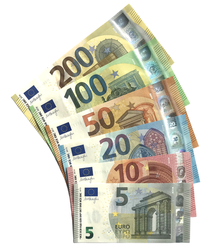

Banknotes of the euro, the common currency of the eurozone (euro area members), have been in circulation since the first series (also called ES1) was issued in 2002. They are issued by the national central banks of the Eurosystem or the European Central Bank.[1] The euro was established in 1999, but "for the first three years it was an invisible currency, used for accounting purposes only, e.g. in electronic payments".[2] In 2002, notes and coins began to circulate. The euro rapidly took over from the former national currencies and slowly expanded around the European Union.
Denominations of the notes range from €5 to €500 and, unlike euro coins, the design is identical across the whole of the eurozone, although they are issued and printed in various member states. The euro banknotes are pure cotton fibre, which improves their durability as well as giving the banknotes a distinctive feel. They measure from 120 by 62 millimetres (4.7 in × 2.4 in) to 160 by 82 millimetres (6.3 in × 3.2 in) and have a variety of color schemes. The euro notes contain many complex security features such as watermarks, invisible ink characteristics, holograms, optically variable inks and microprinting that document their authenticity. While euro coins have a national side indicating the country of issue (although not necessarily of minting), euro notes lack this. Instead, this information is shown by the first character of each note's serial number.
According to European Central Bank estimates, in July 2023, there were about 29.624 billion banknotes in circulation around the eurozone, with a total value of about €1.569 trillion.[3] On 8 November 2012, the ECB announced that the first series of notes would be replaced by the Europa series (also called ES2), starting with the 5 euro note on 2 May 2013.[4] This series does not have a €500 note, as the ECB have decided to permanently cease its production over concerns that it could facilitate illicit activities.[5]
Estimates suggest that the average life of a euro banknote is about three years before replacement due to wear, but with a wide variation by denomination level, from less than a year for €5 banknotes to over 30 years for €500 banknotes, on average. High denomination banknotes (€100, €200, €500) typically last longer as they are less frequently used. The Europa series lower denomination €5 and €10 banknotes are designed to last longer, thanks to additional coating.[6][7][8]
History
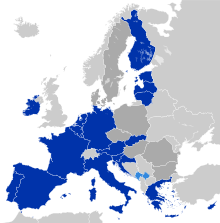
It is also used de facto in two other countries (Kosovo and Montenegro) (light blue)
The euro came into existence on 1 January 1999.[2] The euro's creation had been a goal of the European Union (EU) and its predecessors since the 1960s.[2] The Maastricht Treaty entered into force in 1993 with the goal of creating economic and monetary union by 1999 for all EU states except the UK and Denmark (though Denmark has a policy of a fixed exchange rate with the euro).[9]
Though the currency was born virtually in 1999,[2] notes and coins did not begin to circulate until 2002.[2] The euro rapidly took over from the former national currencies and slowly expanded around the growing EU.[2] In 2009, the Lisbon Treaty formalised the euro's political authority, the Eurogroup, alongside the European Central Bank.[10]
Slovenia joined the eurozone in 2007,[11] Cyprus and Malta in 2008,[12] Slovakia in 2009,[13] Estonia in 2011,[14] Latvia in 2014,[15] Lithuania in 2015[16] and Croatia in 2023.
Specification
There are seven different denominations of euro banknotes: €5, €10, €20, €50, €100, €200, and €500. Each has a distinctive colour and size,[17] and displays examples of a historical European architectural style:[17][18] windows or gateways on the obverse, and bridges on the reverse.[17][18] The architectural examples featured are stylised illustrations of the corresponding style, rather than representations of existing structures.[17][18]
First series
The following table depicts the design characteristics of the 1st series (ES1) of euro notes.
| Image | Value | Year | Dimensions (millimetres) |
Main colour | Design | Printer code position | ||||
|---|---|---|---|---|---|---|---|---|---|---|
| Obverse | Reverse | Architecture | Century | |||||||
| €5 | 2002 | 120 × 62 mm | Grey[19] | Classical | < 5th | Left image edge[20] | ||||
| €10 | 2002 | 127 × 67 mm | Red[21] | Romanesque | 11–12th | 8 o'clock star[22] | ||||

|

|
€20 | 2002 | 133 × 72 mm | Blue[23] | Gothic | 12–14th | 9 o'clock star[24] | ||

|

|
€50 | 2002 | 140 × 77 mm | Orange[25] | Renaissance | 15–16th | Right image edge[26] | ||

|

|
€100 | 2002 | 147 × 82 mm | Green[27] | Baroque and Rococo | 17–18th | Right of 9 o'clock star[28] | ||

|

|
€200 | 2002 | 153 × 82 mm | Yellow[29] | Art Nouveau | 19–20th | Above 7 o'clock star[30] | ||

|

|
€500 | 2002 | 160 × 82 mm | Purple[31] | Modern architecture (20th century) | 20–21st | 9 o'clock star[32] | ||
| These images are to scale at 0.7 pixel per millimetre. For table standards, see the banknote specification table. | ||||||||||
All the notes of the initial series of euro notes bear the European flag, a map of the continent on the reverse, the name "euro" in both Latin and Greek script (EURO / ΕΥΡΩ) and the signature of a president of the ECB, depending on when the banknote was printed.[17][18] The 12 stars from the flag are also incorporated into every note.[17][18]
The notes also carry the acronyms of the name of the European Central Bank in five linguistic variants, covering all official languages of the EU in 2002 (the time of the banknote introduction), and now 19 out of 24 official languages of the EU27, in the following order:[17]
- BCE (French: Banque centrale européenne,[33] Irish: Banc Ceannais Eorpach,[34] Italian: Banca centrale europea,[35] Portuguese: Banco Central Europeu,[36] Spanish: Banco Central Europeo[37])
- ECB (English: European Central Bank,[38] Danish: Europæiske Centralbank,[39] Dutch: Europese Centrale Bank,[40] Swedish: Europeiska centralbanken[41])
- EZB (German: Europäische Zentralbank[42])
- ΕΚΤ (Greek: Ευρωπαϊκή Κεντρική Τράπεζα[43])
- EKP (Finnish: Euroopan keskuspankki[44])[18]
The order is determined by the EU country listing order,[45] with BCE ahead of ECB because of the national precedence of Belgium's two main languages, followed by the remaining languages of Germany and Austria (Deutschland, Österreich), Greece (Ελλάδα, Elláda[46]) and Finland (Suomi), in that order.
The initial designs for the banknotes were chosen from 44 proposals in a design competition, launched by the Council of the European Monetary Institute (EMI) on 12 February 1996.[47] The winning entry, created by Robert Kalina from the Oesterreichische Nationalbank, was selected on 3 December 1996.[47]
The euro banknotes were made of pure cotton fibre, which improves their durability as well as giving the banknotes a distinctive feel.[48]
In the first and Europa series, the Azores, French Guiana, Guadeloupe, Madeira, Martinique, Réunion, and the Canary Islands, overseas territories of the eurozone member states, which also use the euro, were shown under the map in separate boxes. Cyprus and Malta were not shown on the first series because they were not in the EU in 2002, when the banknotes were issued, even though they joined the eurozone in 2008. The map did not stretch as far east as Cyprus, while Malta was too small to be depicted.[18] Both Cyprus and Malta are however depicted on the Europa series note.[4]
Second series
The following table depicts the design characteristics of the second series of euro banknotes (ES2), also known as the Europa series, after the holographic depiction of the mythological Europa common to these banknotes.[49]
| Image | Value | Year | Dimensions (millimetres) |
Main colour | Design | Printer code position | |||||
|---|---|---|---|---|---|---|---|---|---|---|---|
| Obverse | Reverse | Architecture | Century | ||||||||
| €5 | 2013 | 120 × 62 mm | Grey[50] | Classical | < 5th | Top right | |||||
| €10 | 2014 | 127 × 67 mm | Red[51] | Romanesque | 11–12th | Top right | |||||

|

|
€20 | 2015 | 133 × 72 mm | Blue[52] | Gothic | 12–14th | Top right | |||

|

|
€50 | 2017 | 140 × 77 mm | Orange[53] | Renaissance | 15–16th | Top right | |||

|

|
€100 | 2019 | 147 × 77 mm | Green[54] | Baroque & Rococo | 17–18th | Top right | |||

|

|
€200 | 2019 | 153 × 77 mm | Yellow-brown[55] | Art Nouveau | 19–20th | Top right | |||
| These images are to scale at 0.7 pixel per millimetre. For table standards, see the banknote specification table. | |||||||||||
The Europa series banknotes, similarly to the first series, bear the European flag, a map of the continent on the reverse and the signature of Mario Draghi, since 1 November 2011 president of the ECB. The 12 stars from the flag are also incorporated into the notes.[17][18] On 4 May 2016 the European Central Bank decided not to issue a 500 euro banknote for the Europa series.[5]
The series also bears the name of the currency in capital letters, but in three scripts: Latin (EURO), Greek (ΕΥΡΩ), and Cyrillic (ЕВРО).[4]
The 2nd series €100 and €200 notes are a different size to the €100 and €200 notes from the 1st series. Both denominations are now the same height (77 mm) as the €50 banknote, which makes them more comfortable to use. Their length remains unchanged.
The design for the 50, 100 and 200 euro notes features the acronyms of the name of the European Central Bank in ten linguistic variants, covering all official languages of the European Union, in the following order:[4]
- BCE (French: Banque centrale européenne,[33] Irish: Banc Ceannais Eorpach,[56] Italian: Banca centrale europea,[35] Portuguese: Banco Central Europeu,[36] Romanian: Banca Centrală Europeană,[57] Spanish: Banco Central Europeo[37])
- ECB (English: European Central Bank,[38] Czech: Evropská centrální banka,[58] Danish: Europæiske Centralbank,[39] Dutch: Europese Centrale Bank,[40] Latvian: Eiropas Centrālā banka,[59] Lithuanian: Europos Centrinis Bankas,[60] Slovak: Európska centrálna banka,[61] Slovene: Evropska centralna banka,[62] Swedish: Europeiska centralbanken[41])
- ЕЦБ (Bulgarian: Европейска централна банка[63])
- EZB (German: Europäische Zentralbank[42])
- EKP (Estonian: Euroopa Keskpank,[64] Finnish: Euroopan keskuspankki[44])
- ΕΚΤ (Greek: Ευρωπαϊκή Κεντρική Τράπεζα[43])
- ESB (Croatian: Europska središnja banka[65])
- EKB (Hungarian: Európai Központi Bank[66])
- BĊE (Maltese: Bank Ċentrali Ewropew[67])
- EBC (Polish: Europejski Bank Centralny[68])
The 5 euro, 10 euro and 20 euro notes do not feature ESB, as Croatian became an official language only in July 2013 with the accession of Croatia, after the introduction of the banknote design earlier that year. The order in which the acronyms are shown is determined by the same principles as for Series 1:[45] the language of Bulgaria (България/Bulgaria[46]) precedes that of Germany (Deutschland); EKP now precedes ΕΚΤ due to the accession of Estonia (Eesti); and the languages of Croatia (Hrvatska), Hungary (Magyarország), Malta and Poland (Polska) trail the list.
The notes of the Europa series do not show the same year. The year shown is the year the note is issued.
The Europa series euro banknotes are supposedly more durable than the first series banknotes.[4]
Reinhold Gerstetter, an independent banknote designer (and one of participants of the 1996 design contest), was chosen by the European Central Bank to redesign the euro notes.[4]
Third series
In December 2021, the ECB announced plans to redesign euro banknotes by 2024. A theme advisory group, made up of one member from each euro area country, was selected to submit theme proposals to the ECB. The proposals will be voted on by the public; a design competition will also be held.[69] In 2023, the ECB asked the public to vote on a theme for the new design.[70]
Design
Bridges

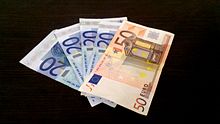
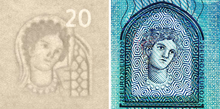

Due to the great number of historic bridges, arches, and gateways throughout the European continent, all the structures represented on the notes are entirely stylized illustrations of the relevant architectural styles, designed to evoke the landmarks within the European Union,[17] representing various European ages and styles.[17] For example, the 5 euro note has a generic rendition of Classical architecture,[17] the 10 euro note of Romanesque architecture,[17] the 20 euro note of Gothic architecture,[17] the 50 euro note of the Renaissance,[17] the 100 euro note of Baroque and Rococo,[17] the 200 euro note of Art Nouveau[17] and the 500 euro note of modern architecture.[17] The initial designs by Robert Kalina were of actual bridges, including the Rialto Bridge in Venice and the Pont de Neuilly in Paris, and were subsequently rendered more generic.[71] In 2011, Dutch artist Robin Stam and the town of Spijkenisse in the Netherlands built seven bridges of colored concrete after the designs on the seven euro banknotes.[72][73][74][75]
Signature
This section needs to be updated. (April 2022) |

The euro banknotes bear the signature of the President of the European Central Bank.[18]
Wim Duisenberg was the first ECB president when the first euro banknotes and coins were issued until 2003.[18] Notes printed between November 2003 and March 2012 show the signature of Jean-Claude Trichet, the second President of the ECB.[18][76] Banknotes printed after March 2012 bear the signature of the third ECB President Mario Draghi.[18]
From 2020, Christine Lagarde's signature will gradually begin to appear on banknotes entering circulation, becoming the fourth signature to appear on euro banknotes.[77]
Security features

The European Central Bank has described some of the basic security features of the euro notes that allow the general public to recognise the authenticity of their currency at a glance:
- For the first series: the firm and crisp paper, the raised print, the watermark, the security thread, the see-through number, the hologram, the micro-perforations, the glossy stripe for €20 and below, the color-changing number for €50 and above, UV light, infrared and the microprint.[78]
- For the Europa series: the firm and crisp paper, the raised print, the portrait watermark, the security thread, the emerald number, the portrait hologram, UV and UV-C, infrared and the microprint.[79]
However, in the interest of advanced security of the euro notes, the full list of these features is a closely guarded secret of the European Central Bank and the National Central Banks of the Eurosystem.

Still, between the official descriptions and independent discoveries made by observant users, it is thought that the euro notes have at least eleven different security features, which are:
- Holograms[78] – The lower value notes carry a holographic band to the right of the obverse. This band contains the denomination, the euro sign, the stars of the EU flag and perforations in the shape of the euro sign. In the Europa series €5 banknote, there is Europa, a gate, 'EURO' and the euro sign, the number 5 and perforations in the shape of a euro sign.[80] The higher-value notes include a holographic decal containing the denomination, the obverse illustration, microprinting, and perforations in the shape of the euro sign.
- Variable colour ink[78] – This appears on the lower right-hand side corner of the reverse of the higher-value notes. When observed from different angles, the colour will change from purple to olive green or brown. This special ink is also on the left bottom on the Europa series notes.[80]
- Checksum – Each note has a unique serial number. The remainder from dividing the serial number by 9 gives checksum corresponding to the initial letter indicated on the note.[81] Using a variation of the divisibility rule shortcut, the remainder from division by 9 can easily be found by adding the constituent digits and, if the sum still does not make the remainder obvious, adding the digits of the sum.[81] Alternatively, substituting the letter with its ASCII value makes the resulting number exactly divisible by 9. Taking the same example, Z10708476264, the ASCII code for Z is 90, so the resulting number is 9010708476264. Dividing by 9 yields a remainder of 0. Using the divisibility rule again, the result can be checked speedily since the addition of all digits gives 54; 5 + 4 = 9—so the number is divisible by 9, or 9010708476264 modulo 9 is 0.[81]
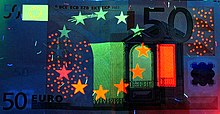
- EURion constellation[82] – Euro banknotes contain a pattern known as the EURion constellation that can be used to detect their identity as banknotes to prevent copying and counterfeiting. Some photocopiers are programmed to reject images containing this pattern.
- Watermarks – There are possibly two watermarks on the euro notes.[80][78][83] They are:
- Standard watermark – Each denomination is printed on uniquely watermarked paper. This may be observed by holding the note up to the light. The thinner parts will show up brighter with backlight illumination and darker with a dark background. In the first series, the standard watermark is a gate/window that is depicted on the note and the denomination,[78] for the €5 of the Europa series, it is the face of Europa and the denomination as well.[80]
- Digital watermark – Like the EURion constellation, a Digimarc digital watermark is embedded in the banknotes' designs. Recent versions of image editors, such as Adobe Photoshop or Paint Shop Pro refuse to process banknotes.[83] This system is called Counterfeit Deterrence System (CDS) and was developed by the Central Bank Counterfeit Deterrence Group.
- Infrared and fluorescent printing patterns[78] – When seen in the near infrared, the banknotes will show darker areas in different zones depending on the denomination. Ultraviolet light will make the EURion constellation show in sharper contrast, and also some fluorescent fibres stand out.

- Security thread[78] – A black magnetic thread in the centre of the note is only seen when held up to the light. It features the denomination of the note, along with the word "euro" in the Latin alphabet and the Greek alphabet.
- Magnetic ink[78] – Some areas of the euro notes feature magnetic ink. For example, the rightmost church window on the €20 note is magnetic, as well as the large zero above it.

- Microprinting[78] – The texture lines to the bottom, like those aligned to the right of ΕΥΡΩ mark on the €5 note, consist of the sequence "EURO ΕΥΡΩ" in microprinting.
- Matted surface[78] – The euro sign and the denomination are printed on a vertical band that is only visible when illuminated at an angle of 45°. This only exists for the lower-value notes.
- Raised print – On every banknote, the initials of the ECB are in raised print. In the first series, every banknote has a bar with raised print lines. On the €200 note of the first series, there are lines at the bottom which are raised to allow blind people to identify the note. On the €500 note of the first series, these lines are on the right-hand side.[78] On the Europa series, there are lines on both sides of the banknote.[80]
- Bar code[clarification needed][78] – When held up to the light, dark bars can be seen to the right of the watermark. The number and width of these bars indicates the denomination of the note. When scanned, these bars are converted to Manchester code.[84]
| Note | Barcode | Manchester |
|---|---|---|
| €5 | 0110 10 | 100 |
| €10 | 0101 10 | 110 |
| €20 | 1010 1010 | 0000 |
| €50 | 0110 1010 | 1000 |
| €100 | 0101 1010 | 1100 |
| €200 | 0101 0110 | 1110 |
| €500 | 0101 0101 | 1111 |
(looked at from the reverse, a dark bar is 1, a bright bar 0)
Europa series


The European Central Bank intends to redesign the notes every seven or eight years. A new series, called the "Europa series", was released from 2013; the first notes entered circulation on 2 May 2013.[85] The new series includes slight changes, notably the inclusion of the face of the mythological princess Europa in the watermark and in the hologram stripe.[86]
New production and anti-counterfeiting techniques are employed on the new notes, but the design shares the colours of the first series and the theme of bridges and arches.[85] The new notes are nonetheless recognisable as a new series.[87]
The new notes also reflect the expansion of the European Union: every member of the EU is depicted on it. The initial series did not include the recent members Cyprus and Malta (Cyprus was off the map to the east and Malta was too small to be depicted.)[18]
The Bulgarian Cyrillic alphabet features on the Europa series banknotes, as a result of Bulgaria joining the European Union in 2007. Thus this series includes "ЕВРО", which is the Bulgarian spelling for EURO, as well as the abbreviation "ЕЦБ" (short for Европейска централна банка in Bulgarian),[88] while set to join the eurozone and abandon Bulgarian lev in 2024. The new banknotes also feature the Maltese abbreviation BĊE (Bank Ċentrali Ewropew)[inconsistent with the above], the Hungarian abbreviation EKB (Európai Központi Bank) and the Polish abbreviation EBC (Europejski Bank Centralny). The modified 5 euro note features the initials of the European Central Bank in each of the contemporary EU member languages in a column on the left-hand side of the obverse.[88] The word "euro" in Latin, Greek, and Cyrillic lettering has also been moved to a more central position.[88]
The full design of the Europa series 5 euro banknote was revealed on 10 January 2013.[89] The new note entered circulation on 2 May 2013.[90] The full design of the Europa series 10 euro note was revealed on 13 January 2014 and it entered circulation on 23 September 2014.[91] The full design of the Europa series 20 euro banknote was revealed on 24 February 2015, [92][93] and it was launched on 25 November 2015.[92] The full design of the Europa series 50 euro note was revealed on 5 July 2016[94] and the new 50 note was released on 4 April 2017.[95][96] The full design of the Europa series 100 euro banknote and 200 euro banknote was revealed on 17 September 2018 and the new notes entered circulation on 28 May 2019[97] therefore "will complete the issuance of the Europa series."[98]
On 4 May 2016, the European Central Bank announced that a Europa series 500 euro banknote would not be released, due to fears of facilitating criminal activity.[5][99][100] "The ECB has decided to stop producing the €500 banknote, although the first series €500 remains legal tender."[98]
The old series will gradually be withdrawn.[98] The ECB will announce "well in advance" when the old notes will lose their legal tender status.[98] However, they will not lose their value and it will be possible to exchange them for new notes at Eurosystem central banks indefinitely.[85][98]
Security features

- Watermark: When the note is held under a normal light source, a portrait of Europa and an electrotype denomination appear on either side.[85][101]
- Portrait hologram: When the note is tilted, the silver-coloured holographic stripe reveals the portrait of Europa – the same one as in the watermark. The stripe also reveals a window and the value of the banknote.[85][101]
- Colour changing ink: When the note is tilted, the number on the note displays an effect of light that moves up and down. The number also changes colour from emerald green to deep blue.[85][101]
- Raised printing: On the front of the note, there is a series of short raised lines on the left and right edges. The main edge, the lettering and the large value numeral also feel thicker.[85][101]
- Security thread: When the note is held against the light, the security thread appears as a dark line. The euro symbol (€) and the value of the banknote can be seen in tiny white lettering in the thread.[85][101]
- Microprinting: Tiny letters which can be read with a magnifying glass. The letters should be sharp, not blurred.[101]
- Ultraviolet ink: Some parts of the banknote shine when under UV or UV-C light. These are the stars in the flag, the small circles, the large stars and several other areas on the front. On the back, a quarter of a circle in the centre as well as several other areas glow green. The horizontal serial number and a stripe appear in red.[101]
- Infrared light: Under infrared light, the emerald number, the right side of the main image and the silvery stripe are visible on the obverse of the banknote, while on the reverse, only the denomination and the horizontal serial number are visible.[101]
- Glossy stripe: On the back side, over the map of Europe. Depending on the viewing angle, the glossy stripe appears golden or is nearly invisible.[102]
Features for people with impaired sight
"A good design for the blind and partially sighted is a good design for everybody" was the principle behind the cooperation of the European Central Bank and the European Blind Union during the design phase of the first series banknotes in the 1990s.[103] As a result, the design of the first euro banknotes include several characteristics which help both the blind and partially sighted to use the notes with greater confidence.[103]
Features for blind and visually impaired users include:
Zdroj:https://en.wikipedia.org?pojem=Euro_banknotesText je dostupný za podmienok Creative Commons Attribution/Share-Alike License 3.0 Unported; prípadne za ďalších podmienok. Podrobnejšie informácie nájdete na stránke Podmienky použitia.
Antropológia
Aplikované vedy
Bibliometria
Dejiny vedy
Encyklopédie
Filozofia vedy
Forenzné vedy
Humanitné vedy
Knižničná veda
Kryogenika
Kryptológia
Kulturológia
Literárna veda
Medzidisciplinárne oblasti
Metódy kvantitatívnej analýzy
Metavedy
Metodika
Text je dostupný za podmienok Creative
Commons Attribution/Share-Alike License 3.0 Unported; prípadne za ďalších
podmienok.
Podrobnejšie informácie nájdete na stránke Podmienky
použitia.
www.astronomia.sk | www.biologia.sk | www.botanika.sk | www.dejiny.sk | www.economy.sk | www.elektrotechnika.sk | www.estetika.sk | www.farmakologia.sk | www.filozofia.sk | Fyzika | www.futurologia.sk | www.genetika.sk | www.chemia.sk | www.lingvistika.sk | www.politologia.sk | www.psychologia.sk | www.sexuologia.sk | www.sociologia.sk | www.veda.sk I www.zoologia.sk






